Attached files
| file | filename |
|---|---|
| 8-K - FORM 8-K - Roadrunner Transportation Systems, Inc. | c21149e8vk.htm |
Exhibit 99.1
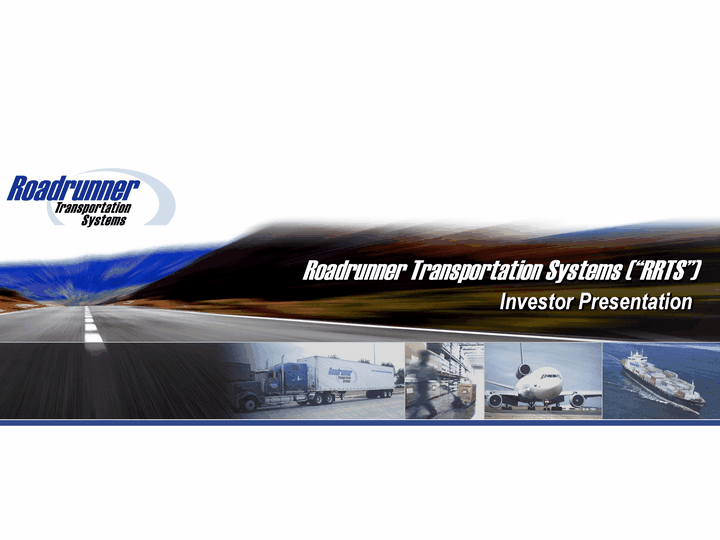
| Investor Presentation |
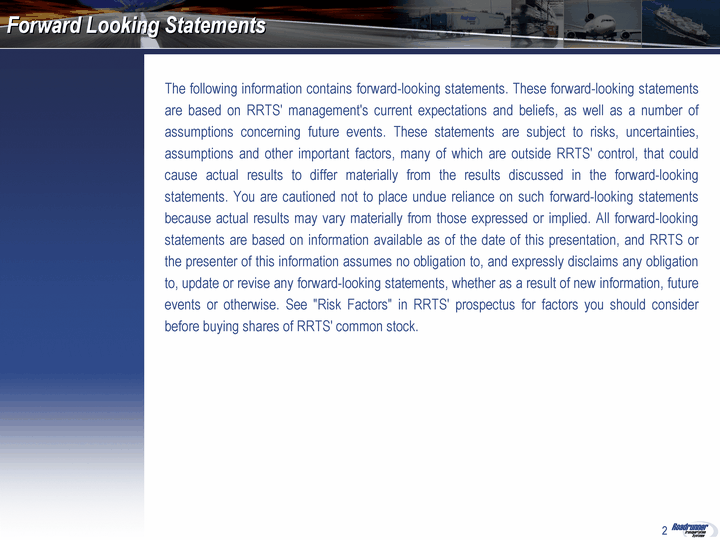
| 2 Forward Looking Statements The following information contains forward-looking statements. These forward-looking statements are based on RRTS' management's current expectations and beliefs, as well as a number of assumptions concerning future events. These statements are subject to risks, uncertainties, assumptions and other important factors, many of which are outside RRTS' control, that could cause actual results to differ materially from the results discussed in the forward-looking statements. You are cautioned not to place undue reliance on such forward-looking statements because actual results may vary materially from those expressed or implied. All forward-looking statements are based on information available as of the date of this presentation, and RRTS or the presenter of this information assumes no obligation to, and expressly disclaims any obligation to, update or revise any forward-looking statements, whether as a result of new information, future events or otherwise. See "Risk Factors" in RRTS' prospectus for factors you should consider before buying shares of RRTS' common stock. |
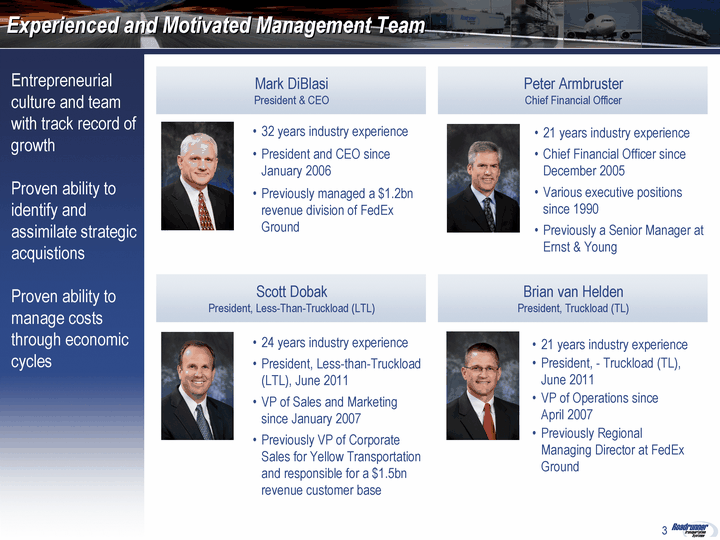
| 3 Experienced and Motivated Management Team Entrepreneurial culture and team with track record of growth Proven ability to identify and assimilate strategic acquistions Proven ability to manage costs through economic cycles 32 years industry experience President and CEO since January 2006 Previously managed a $1.2bn revenue division of FedEx Ground 21 years industry experience Chief Financial Officer since December 2005 Various executive positions since 1990 Previously a Senior Manager at Ernst & Young 24 years industry experience President, Less-than-Truckload (LTL), June 2011 VP of Sales and Marketing since January 2007 Previously VP of Corporate Sales for Yellow Transportation and responsible for a $1.5bn revenue customer base 21 years industry experience President, - Truckload (TL), June 2011 VP of Operations since April 2007 Previously Regional Managing Director at FedEx Ground Mark DiBlasi President & CEO Peter Armbruster Chief Financial Officer Scott Dobak President, Less-Than-Truckload (LTL) Brian van Helden President, Truckload (TL) |
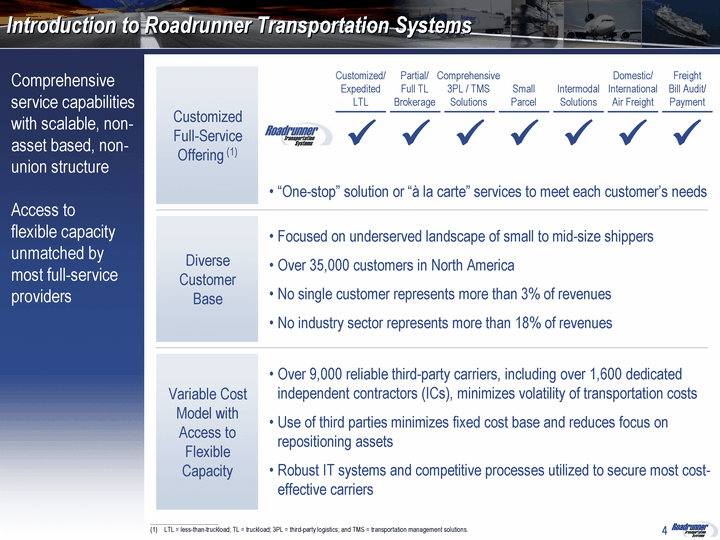
| Introduction to Roadrunner Transportation Systems 4 Comprehensive service capabilities with scalable, non- asset based, non- union structure Access to flexible capacity unmatched by most full-service providers Focused on underserved landscape of small to mid-size shippers Over 35,000 customers in North America No single customer represents more than 3% of revenues No industry sector represents more than 18% of revenues Over 9,000 reliable third-party carriers, including over 1,600 dedicated independent contractors (ICs), minimizes volatility of transportation costs Use of third parties minimizes fixed cost base and reduces focus on repositioning assets Robust IT systems and competitive processes utilized to secure most cost- effective carriers Customized Full-Service Offering (1) _____________________ (1) LTL = less-than-truckload; TL = truckload; 3PL = third-party logistics; and TMS = transportation management solutions. Diverse Customer Base Variable Cost Model with Access to Flexible Capacity Customized/ Expedited LTL Partial/ Full TL Brokerage Comprehensive 3PL / TMS Solutions Small Parcel Intermodal Solutions Domestic/ International Air Freight Freight Bill Audit/ Payment ? ? ? ? ? ? ? "One-stop" solution or "a la carte" services to meet each customer's needs |
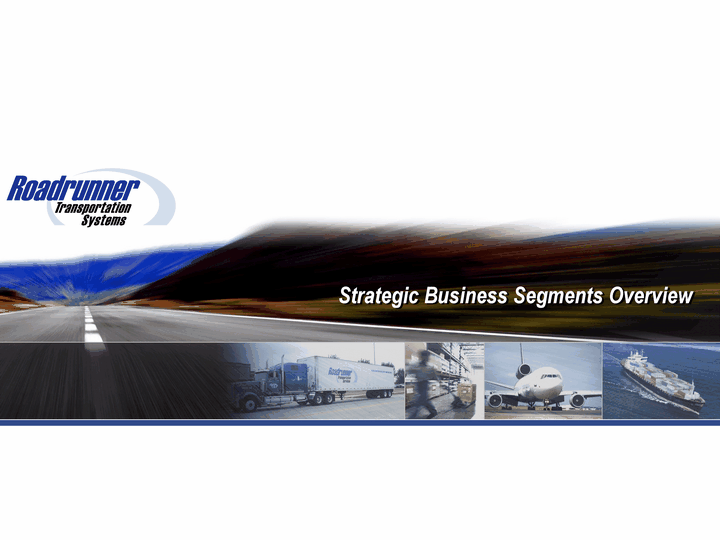
| Strategic Business Segments Overview |
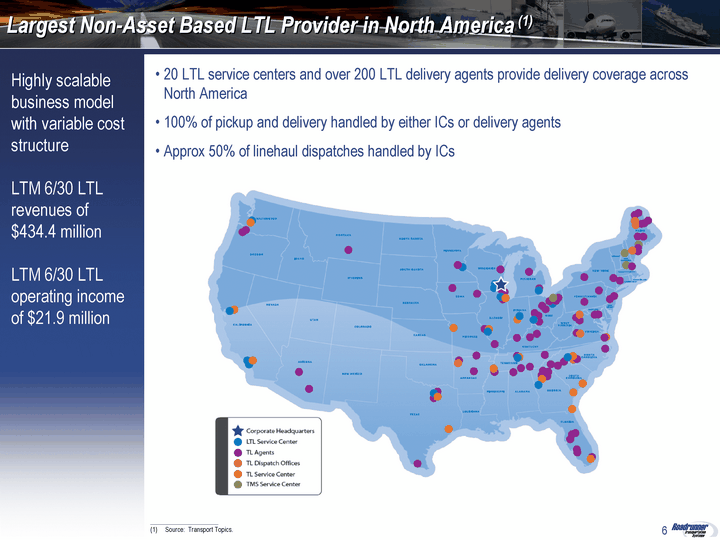
| 6 Largest Non-Asset Based LTL Provider in North America (1) Highly scalable business model with variable cost structure LTM 6/30 LTL revenues of $434.4 million LTM 6/30 LTL operating income of $21.9 million 20 LTL service centers and over 200 LTL delivery agents provide delivery coverage across North America 100% of pickup and delivery handled by either ICs or delivery agents Approx 50% of linehaul dispatches handled by ICs _____________________ Source: Transport Topics. |
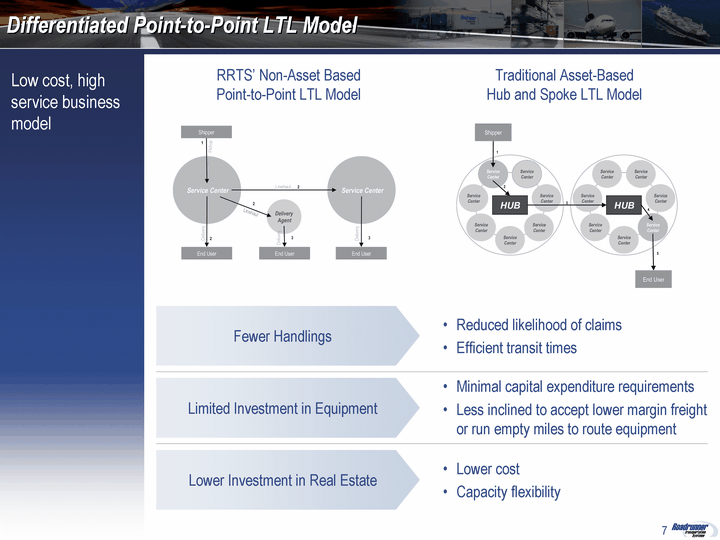
| 7 Differentiated Point-to-Point LTL Model Low cost, high service business model Traditional Asset-Based Hub and Spoke LTL Model RRTS' Non-Asset Based Point-to-Point LTL Model Reduced likelihood of claims Efficient transit times Fewer Handlings Minimal capital expenditure requirements Less inclined to accept lower margin freight or run empty miles to route equipment Limited Investment in Equipment Lower cost Capacity flexibility Lower Investment in Real Estate Pickup Linehaul Linehaul Delivery Delivery Delivery |
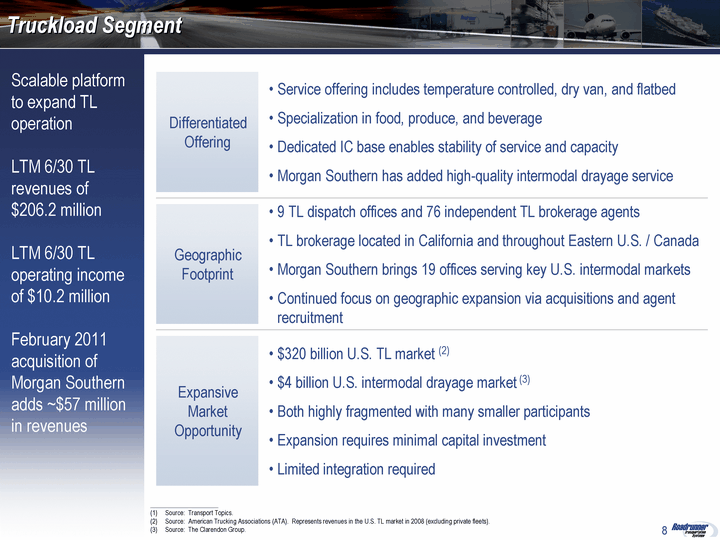
| Truckload Segment Scalable platform to expand TL operation LTM 6/30 TL revenues of $206.2 million LTM 6/30 TL operating income of $10.2 million February 2011 acquisition of Morgan Southern adds ~$57 million in revenues Expansive Market Opportunity Differentiated Offering Geographic Footprint 8 _____________________ Source: Transport Topics. Source: American Trucking Associations (ATA). Represents revenues in the U.S. TL market in 2008 (excluding private fleets). Source: The Clarendon Group. $320 billion U.S. TL market (2) $4 billion U.S. intermodal drayage market (3) Both highly fragmented with many smaller participants Expansion requires minimal capital investment Limited integration required Service offering includes temperature controlled, dry van, and flatbed Specialization in food, produce, and beverage Dedicated IC base enables stability of service and capacity Morgan Southern has added high-quality intermodal drayage service 9 TL dispatch offices and 76 independent TL brokerage agents TL brokerage located in California and throughout Eastern U.S. / Canada Morgan Southern brings 19 offices serving key U.S. intermodal markets Continued focus on geographic expansion via acquisitions and agent recruitment |
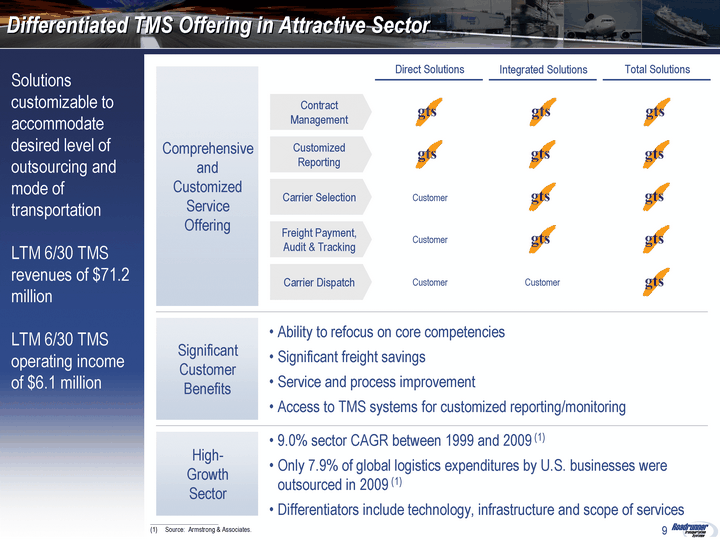
| 9 Differentiated TMS Offering in Attractive Sector Significant Customer Benefits Ability to refocus on core competencies Significant freight savings Service and process improvement Access to TMS systems for customized reporting/monitoring Solutions customizable to accommodate desired level of outsourcing and mode of transportation LTM 6/30 TMS revenues of $71.2 million LTM 6/30 TMS operating income of $6.1 million High- Growth Sector Total Solutions Integrated Solutions Direct Solutions Contract Management Customer Freight Payment, Audit & Tracking Customer Customer Carrier Dispatch Carrier Selection Customer Comprehensive and Customized Service Offering Customized Reporting _____________________ Source: Armstrong & Associates. 9.0% sector CAGR between 1999 and 2009 (1) Only 7.9% of global logistics expenditures by U.S. businesses were outsourced in 2009 (1) Differentiators include technology, infrastructure and scope of services |
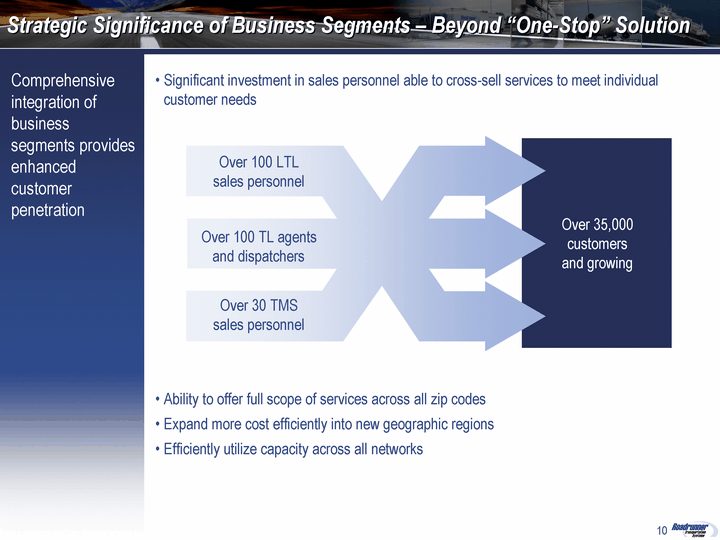
| Significant investment in sales personnel able to cross-sell services to meet individual customer needs Ability to offer full scope of services across all zip codes Expand more cost efficiently into new geographic regions Efficiently utilize capacity across all networks Over 35,000 customers and growing Strategic Significance of Business Segments - Beyond "One-Stop" Solution 10 Comprehensive integration of business segments provides enhanced customer penetration Over 100 LTL sales personnel Over 100 TL agents and dispatchers Over 30 TMS sales personnel |
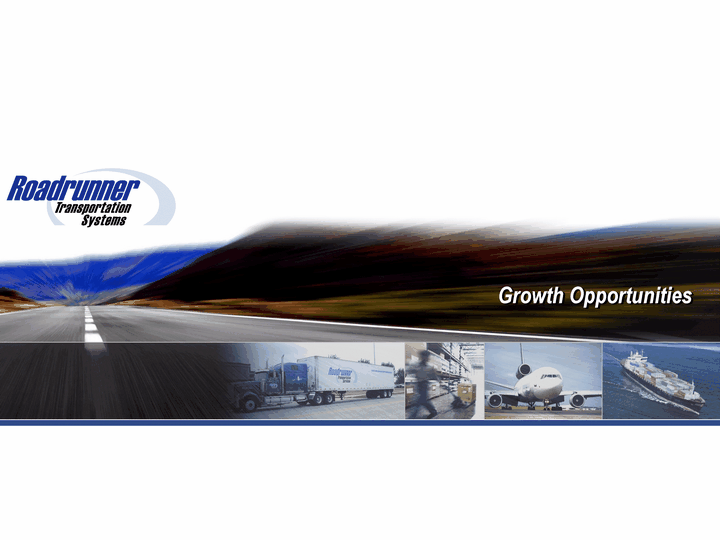
| Growth Opportunities |
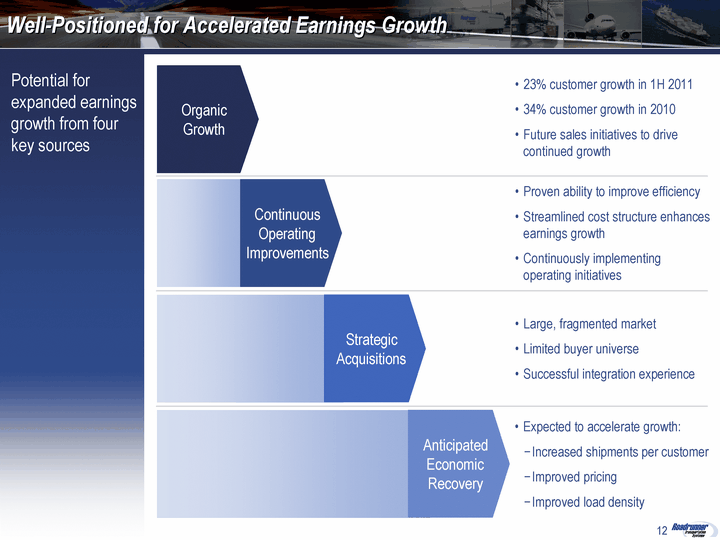
| Well-Positioned for Accelerated Earnings Growth 12 Potential for expanded earnings growth from four key sources Organic Growth Continuous Operating Improvements Strategic Acquisitions Anticipated Economic Recovery 23% customer growth in 1H 2011 34% customer growth in 2010 Future sales initiatives to drive continued growth Proven ability to improve efficiency Streamlined cost structure enhances earnings growth Continuously implementing operating initiatives Large, fragmented market Limited buyer universe Successful integration experience Expected to accelerate growth: Increased shipments per customer Improved pricing Improved load density |
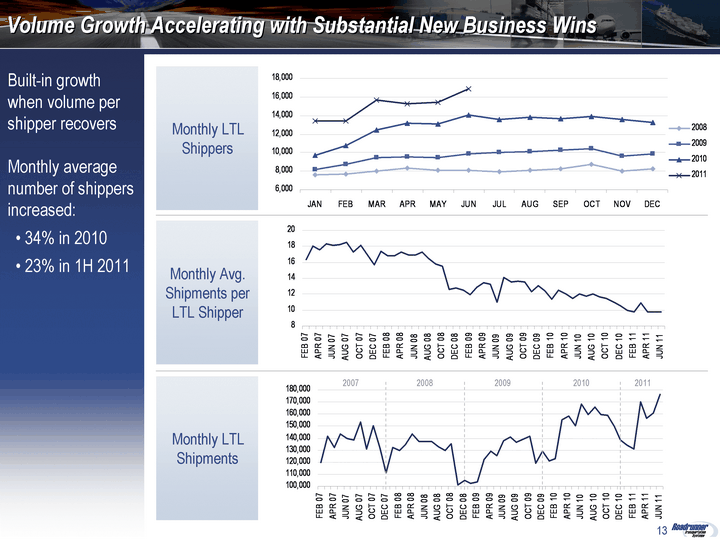
| 13 Volume Growth Accelerating with Substantial New Business Wins Built-in growth when volume per shipper recovers Monthly average number of shippers increased: • 34% in 2010 • 23% in 1H 2011 Monthly LTL Shippers Monthly LTL Shipments Monthly Avg. Shipments per LTL Shipper 2007 2008 2009 2010 2011 |
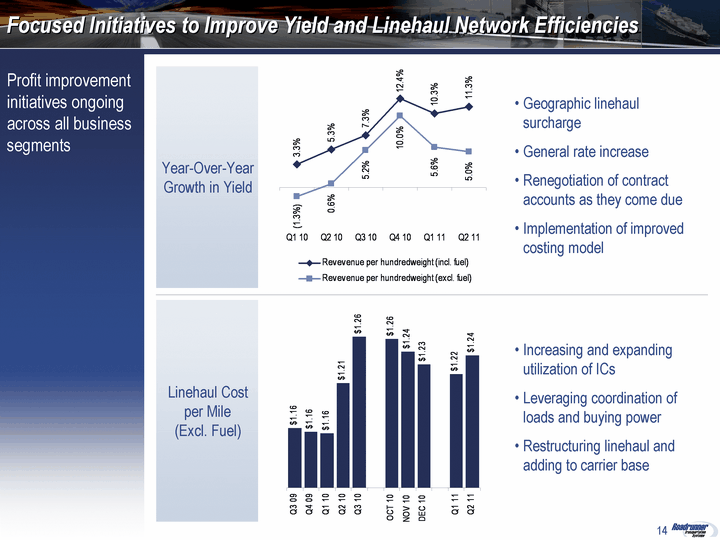
| Focused Initiatives to Improve Yield and Linehaul Network Efficiencies Geographic linehaul surcharge General rate increase Renegotiation of contract accounts as they come due Implementation of improved costing model Profit improvement initiatives ongoing across all business segments 14 Year-Over-Year Growth in Yield Linehaul Cost per Mile (Excl. Fuel) Increasing and expanding utilization of ICs Leveraging coordination of loads and buying power Restructuring linehaul and adding to carrier base |
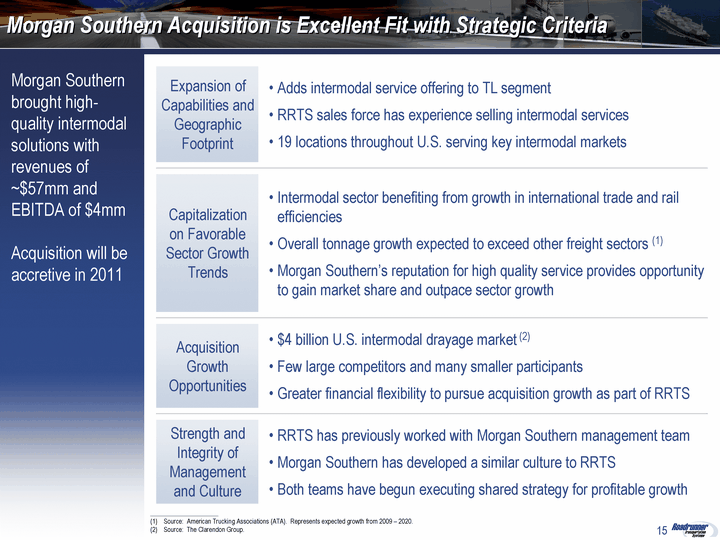
| Morgan Southern Acquisition is Excellent Fit with Strategic Criteria Morgan Southern brought high- quality intermodal solutions with revenues of ~$57mm and EBITDA of $4mm Acquisition will be accretive in 2011 15 Capitalization on Favorable Sector Growth Trends Acquisition Growth Opportunities Intermodal sector benefiting from growth in international trade and rail efficiencies Overall tonnage growth expected to exceed other freight sectors (1) Morgan Southern's reputation for high quality service provides opportunity to gain market share and outpace sector growth $4 billion U.S. intermodal drayage market (2) Few large competitors and many smaller participants Greater financial flexibility to pursue acquisition growth as part of RRTS _____________________ Source: American Trucking Associations (ATA). Represents expected growth from 2009 - 2020. Source: The Clarendon Group. Expansion of Capabilities and Geographic Footprint Adds intermodal service offering to TL segment RRTS sales force has experience selling intermodal services 19 locations throughout U.S. serving key intermodal markets Strength and Integrity of Management and Culture RRTS has previously worked with Morgan Southern management team Morgan Southern has developed a similar culture to RRTS Both teams have begun executing shared strategy for profitable growth |
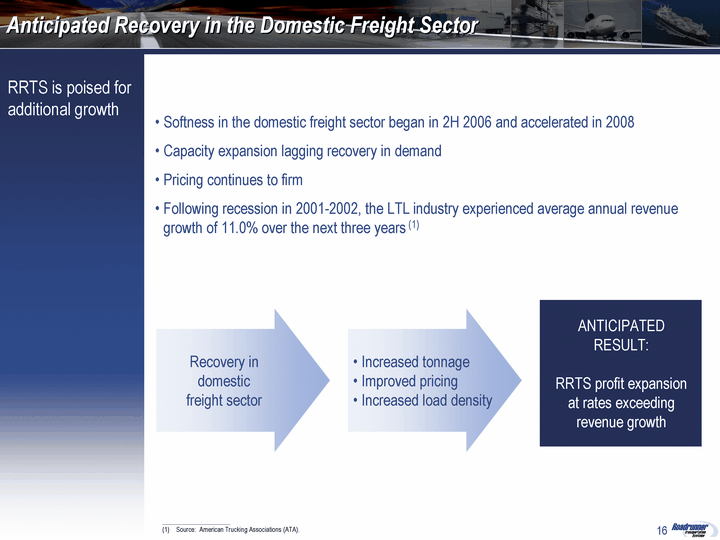
| Anticipated Recovery in the Domestic Freight Sector Increased tonnage Improved pricing Increased load density Recovery in domestic freight sector ANTICIPATED RESULT: RRTS profit expansion at rates exceeding revenue growth Softness in the domestic freight sector began in 2H 2006 and accelerated in 2008 Capacity expansion lagging recovery in demand Pricing continues to firm Following recession in 2001-2002, the LTL industry experienced average annual revenue growth of 11.0% over the next three years (1) RRTS is poised for additional growth 16 _____________________ (1) Source: American Trucking Associations (ATA). |
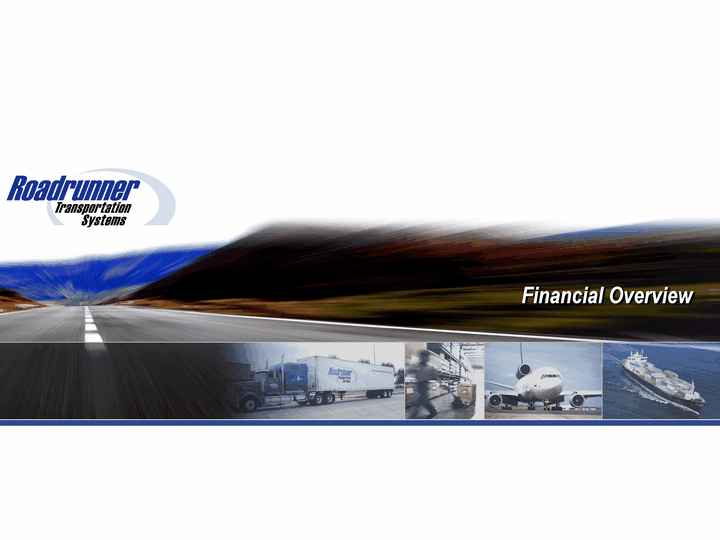
| Financial Overview |
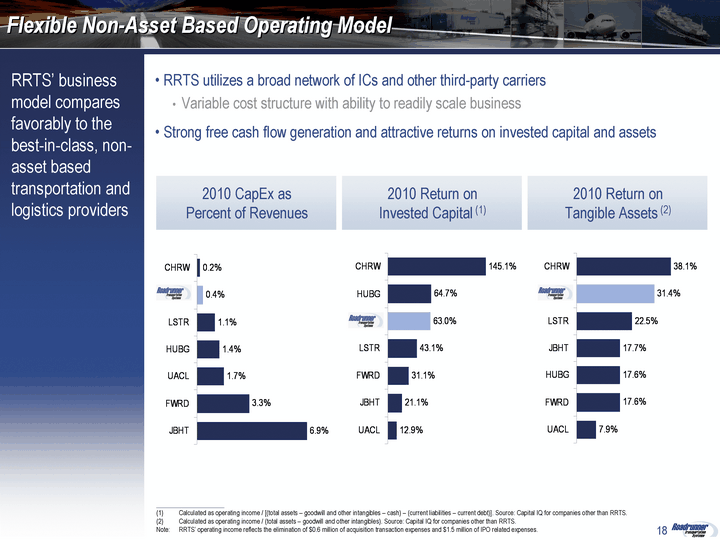
| Flexible Non-Asset Based Operating Model RRTS utilizes a broad network of ICs and other third-party carriers Variable cost structure with ability to readily scale business Strong free cash flow generation and attractive returns on invested capital and assets 18 2010 CapEx as Percent of Revenues 2010 Return on Invested Capital (1) 2010 Return on Tangible Assets (2) RRTS' business model compares favorably to the best-in-class, non- asset based transportation and logistics providers _____________________ Calculated as operating income / [(total assets - goodwill and other intangibles - cash) - (current liabilities - current debt)]. Source: Capital IQ for companies other than RRTS. Calculated as operating income / (total assets - goodwill and other intangibles). Source: Capital IQ for companies other than RRTS. Note: RRTS' operating income reflects the elimination of $0.6 million of acquisition transaction expenses and $1.5 million of IPO related expenses. |
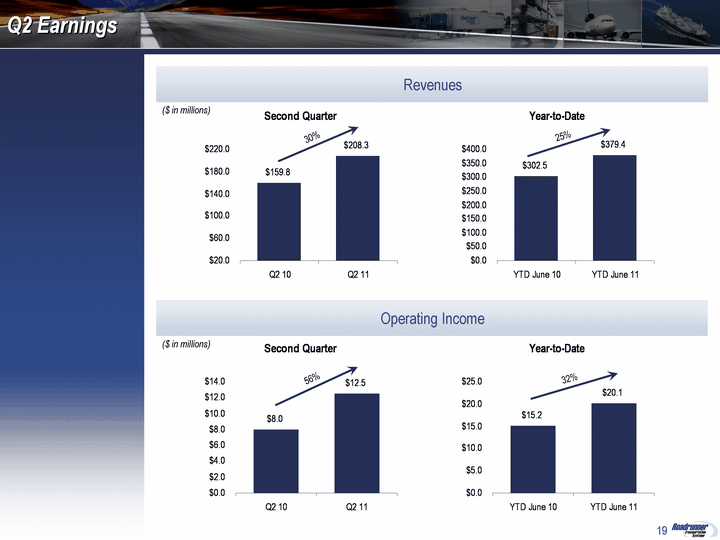
| Q2 Earnings 19 Revenues ($ in millions) Operating Income ($ in millions) 25% 30% 56% 32% |
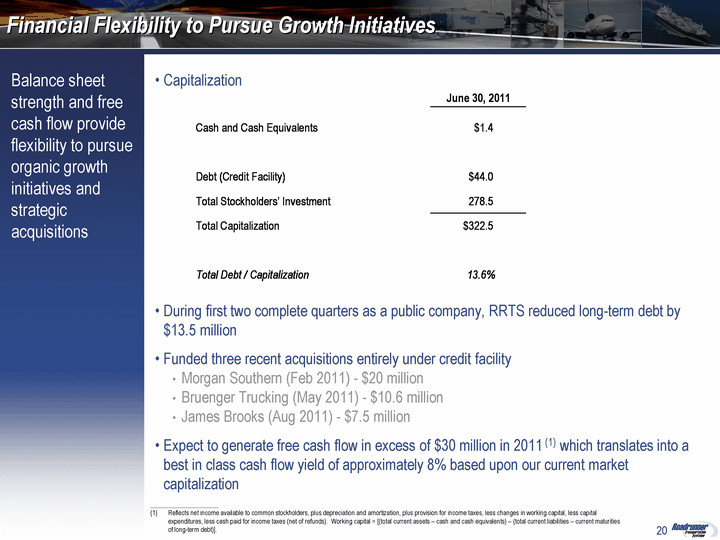
| Capitalization During first two complete quarters as a public company, RRTS reduced long-term debt by $13.5 million Funded three recent acquisitions entirely under credit facility Morgan Southern (Feb 2011) - $20 million Bruenger Trucking (May 2011) - $10.6 million James Brooks (Aug 2011) - $7.5 million Expect to generate free cash flow in excess of $30 million in 2011 (1) which translates into a best in class cash flow yield of approximately 8% based upon our current market capitalization Financial Flexibility to Pursue Growth Initiatives 20 Balance sheet strength and free cash flow provide flexibility to pursue organic growth initiatives and strategic acquisitions _____________________ Reflects net income available to common stockholders, plus depreciation and amortization, plus provision for income taxes, less changes in working capital, less capital expenditures, less cash paid for income taxes (net of refunds). Working capital = [(total current assets - cash and cash equivalents) - (total current liabilities - current maturities of long-term debt)]. |
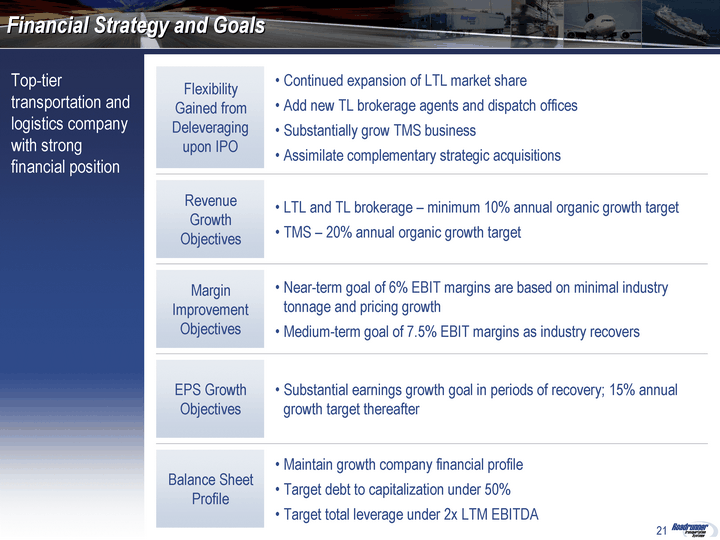
| 21 Financial Strategy and Goals Flexibility Gained from Deleveraging upon IPO Revenue Growth Objectives Margin Improvement Objectives EPS Growth Objectives Continued expansion of LTL market share Add new TL brokerage agents and dispatch offices Substantially grow TMS business Assimilate complementary strategic acquisitions Near-term goal of 6% EBIT margins are based on minimal industry tonnage and pricing growth Medium-term goal of 7.5% EBIT margins as industry recovers LTL and TL brokerage - minimum 10% annual organic growth target TMS - 20% annual organic growth target Substantial earnings growth goal in periods of recovery; 15% annual growth target thereafter Top-tier transportation and logistics company with strong financial position Balance Sheet Profile Maintain growth company financial profile Target debt to capitalization under 50% Target total leverage under 2x LTM EBITDA |
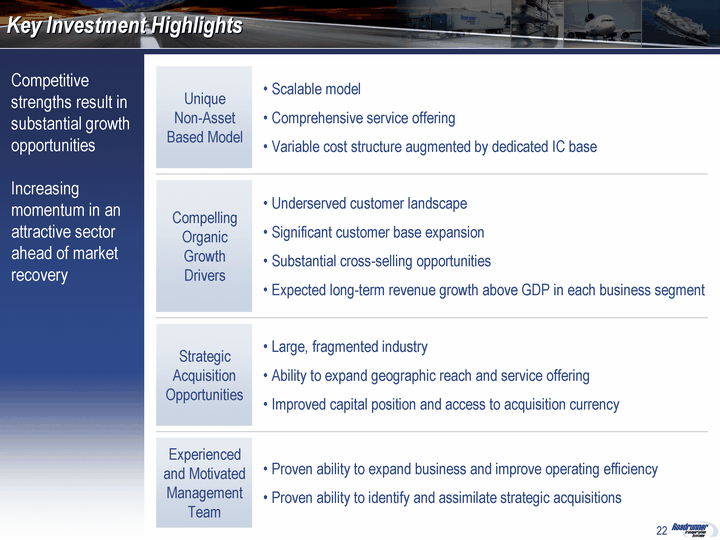
| 22 Key Investment Highlights Competitive strengths result in substantial growth opportunities Increasing momentum in an attractive sector ahead of market recovery Unique Non-Asset Based Model Compelling Organic Growth Drivers Strategic Acquisition Opportunities Experienced and Motivated Management Team Scalable model Comprehensive service offering Variable cost structure augmented by dedicated IC base Underserved customer landscape Significant customer base expansion Substantial cross-selling opportunities Expected long-term revenue growth above GDP in each business segment Large, fragmented industry Ability to expand geographic reach and service offering Improved capital position and access to acquisition currency Proven ability to expand business and improve operating efficiency Proven ability to identify and assimilate strategic acquisitions |
